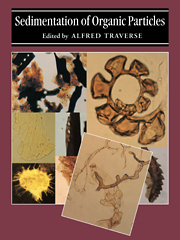Book contents
- Frontmatter
- Contents
- Editor's preface
- List of contributors
- I Introduction
- II Studies of palynosedimentation in modern environments
- 2 The sorting of spores and pollen by water: experimental and field evidence
- 3 Transport and deposition of pollen in an estuary: signature of the landscape
- 4 Pollen preservation in alkaline soils of the American Southwest
- 5 Wind and water transport and sedimentation of miospores along two rivers subject to major floods and entering the Mediterranean Sea at Calvi (Corsica, France)
- 6 Sedimentation of land-derived palynomorphs in the Trinity–Galveston Bay area, Texas
- 7 The genesis and sedimentation of phytoclasts with examples from coastal environments
- 8 Palynofacies of some recent marine sediments: the role of transportation
- 9 Maceral palynofacies of the Louisiana deltaic plain in terms of organic constituents and hydrocarbon potential
- 10 Organic sedimentation in a carbonate region
- 11 An approach to a standard terminology for palynodebris
- 12 Relationships of palynofacies to coal-depositional environments in the upper Paleocene of the Gulf Coast Basin, Texas, and the Powder River Basin, Montana and Wyoming
- III Reconstruction of late Cenozoic vegetation and sedimentary environments from palynological data
- IV Application of data on palynosedimentation to solution of geological problems
- V Appendix
- Index
10 - Organic sedimentation in a carbonate region
Published online by Cambridge University Press: 06 January 2010
- Frontmatter
- Contents
- Editor's preface
- List of contributors
- I Introduction
- II Studies of palynosedimentation in modern environments
- 2 The sorting of spores and pollen by water: experimental and field evidence
- 3 Transport and deposition of pollen in an estuary: signature of the landscape
- 4 Pollen preservation in alkaline soils of the American Southwest
- 5 Wind and water transport and sedimentation of miospores along two rivers subject to major floods and entering the Mediterranean Sea at Calvi (Corsica, France)
- 6 Sedimentation of land-derived palynomorphs in the Trinity–Galveston Bay area, Texas
- 7 The genesis and sedimentation of phytoclasts with examples from coastal environments
- 8 Palynofacies of some recent marine sediments: the role of transportation
- 9 Maceral palynofacies of the Louisiana deltaic plain in terms of organic constituents and hydrocarbon potential
- 10 Organic sedimentation in a carbonate region
- 11 An approach to a standard terminology for palynodebris
- 12 Relationships of palynofacies to coal-depositional environments in the upper Paleocene of the Gulf Coast Basin, Texas, and the Powder River Basin, Montana and Wyoming
- III Reconstruction of late Cenozoic vegetation and sedimentary environments from palynological data
- IV Application of data on palynosedimentation to solution of geological problems
- V Appendix
- Index
Summary
Introduction
The study of disseminated organic matter in sediments to determine characteristics of the depositional environment dates back to the early work in palynology. The basic reasoning is that the organic material contained in sediments derives from living organisms, and much of that material is autochthonous. Preservation of organic matter in sediments is primarily a function of the effects of the surface, depositional, and diagenetic environments upon the dead organism or parts thereof. The types of organisms and the chemical and biological alterations following death determine the types of particulate organic matter (macerals) found in the sediments. As a consequence, the maceral spectra derived from a sedimentary rock may have a strong autochthonous component which often can be used to extract information about the environment of deposition (Darrell & Hart, 1970; Hart, 1971, 1975, 1976, 1979a,b, 1986; Hart et al., 1989; LeNoir & Hart, 1986, 1988; Wrenn & Beckman, 1981, 1982). It should also be stressed that land-derived palynomorphs and other organic particles can indicate sedimentary environments due to sorting in the marine realm (Traverse & Ginsburg, 1966).
The descriptive classification system used to identify the macerals (Hart, 1979, 1986; see also Hart and Hart et al., Chaps. 9 & 17 this volume) divides them into phytoclasts (plant-derived), zooclasts (animal-derived), protistoclasts (protistan-derived) and scleratoclasts (fungalderived), using the five-kingdom system of classification of organisms of Whittaker (1969). Based on the preservational state of cell walls, each of these biological categories consists of well-preserved (little evidence of biodegradation); poorly preserved (minor biodegradation); infested (cell walls highly disrupted by organic attack); amorphous structured (remnant cell structure only); amorphous non-structured (blocky phytoclast mass or fluffy protistoclast mass).
- Type
- Chapter
- Information
- Sedimentation of Organic Particles , pp. 177 - 198Publisher: Cambridge University PressPrint publication year: 1994
- 1
- Cited by

